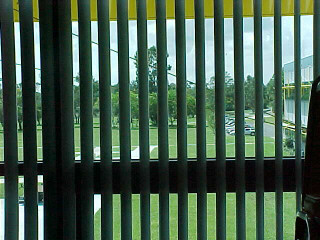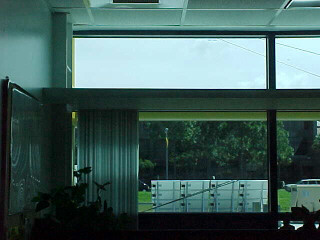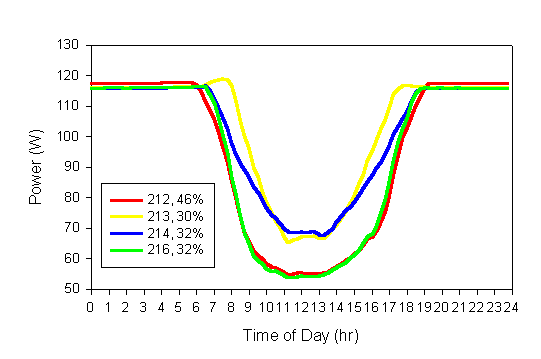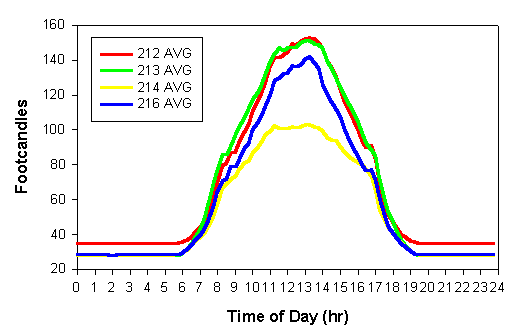
Reference Publication: Floyd, D., Parker, D., "Daylighting: Measuring the Performance of Light Shelves and Occupant-Controlled Blinds on a Dimmed Lighting System," Presented at the 11th Symposium on Improving Building Systems in Hot and Humid Climates, Fort Worth, Texas, June 1-2, 1998. Disclaimer: The views and opinions expressed in this article are solely those of the authors and are not intended to represent the views and opinions of the Florida Solar Energy Center. |
Daylighting: Measuring the Performance of
Light Shelves and
Occupant-Controlled
Blinds on a Dimmed Lighting System
David B. Floyd, Danny S. Parker
Florida
Solar Energy Center (FSEC)
FSEC-PF-340-98
Abstract
The design of a daylighted space is both an art and a science. The biggest challenge facing the lighting designer is to admit only as much light as necessary and distribute it evenly throughout the space without introducing glare or heat. In warm climates such as Florida, it has become common practice in windowed spaces to specify blinds and glazing with high shading coefficients to control glare and minimize heat gain. However, this practice reduces the effectiveness of lighting systems that dim automatically. Improved systems are needed to capture natural daylight and distribute it uniformly throughout a space while controlling heat gain and glare. One such system is the light shelf. Light shelves shade the space from direct sunlight and reflect this sunlight onto the ceiling for a deeper and more uniform distribution. While this is not a new idea, little unbiased empirical data has been collected, outside the laboratory, that compares the performance (energy savings, uniformity, and level) of an automatic daylighting system.
This study measures the effectiveness of light shelves and manually controlled horizontal blinds in an automatic daylighting system. Power consumption and interior work-plane lighting levels were compared in four essentially identical private offices. Two offices were configured with an interior light shelf, one with a white diffuse top surface and the other with a specular surface. The third office had no window treatment and the fourth office had horizontal blinds, which were manually adjusted by the user. All offices had two lamp fluorescent luminaires with dimming ballasts (min. 20%) controlled by a ceiling mounted photosensor. The study showed that daytime savings ranged from 29% to 46%, with the largest savings from the office with the light shelves. The office with horizontal blinds showed the poor savings (32%) and also the poorest light uniformity and level.
Introduction
Recent introduction of electronic dimming ballasts have excited utilities, facility managers, and engineers in their search for new technologies to reduce energy. Previous use of these dimming ballasts was primarily for manual dimming in areas such as conference rooms, although now they are increasingly being used to capture savings automatically in areas where daylight is available. The most common application of these ballasts appears to be in areas daylighted by windows. Typical daylighted offices in warm climates such as Florida often have internal or external shading devices to reduce heat and glare. Common shading devices are window film, vertical or horizontal blinds, drapes, and overhangs.

Vertical blinds in an office at FSEC
While these devices often control heat and glare they do so at the expense of visible light. The reduction in visible light reduces the overall effectiveness of the dimming ballasts. For instance, in three large commercial buildings in Canada (51° N latitude) it was found that daylighting systems functioned poorly due to the use of glazings with low visible transmittance and low interior reflectance (Love, J. A., 1995).

Lightshelves in the South facing windows at FSEC
A literature review yielded few studies that examined the interaction that shading systems have on daylight-linked fluorescent dimming in the field. Schrum et al. (1996) researched the effects of window orientation on savings, however the blinds were fixed in horizontal position. Savings were found to be greatest on the southern exposure (37%). Another study conducted in a Florida school cafeteria, measured savings due to dimming at 27% although many commissioning difficulties were encountered (Floyd et al. 1996). This study expands the knowledge by examining different shading systems in "real world" offices side lighted from the south. In the study, four very similar offices were instrumented to measure power and illumination to determine how different shading devices effect power savings and illumination uniformity. The reason for conducting the study was two fold, first to select a suitable shading device for the southern offices at the Florida Solar Energy Center's newly constructed building and second to evaluate each devices performance, primarily, energy savings, illumination uniformity and glare control.
Office Monitoring
Four occupied offices at the Florida Solar Energy Center were chosen to evaluate different interior shading systems. All offices were identical in size, window opening, and lighting systems. All offices had three walls painted flat white and a single wall (perpendicular to the window) painted flat yellow, green, or blue (68%, 40%, 31% reflectance respectively). While each office did have a different colored wall, this impact appeared to be minor. Comparisons between the office with the lowest wall reflectance (blue) and the office with the greatest wall reflectance (yellow) showed only a 4% difference in average illumination levels at night with the lights on. All offices measured 9' by 13' and were daylighted on the south side by a large window that extended from desktop height to the top of the 9' ceiling. The glazing is spectrally selective to allow most of the visible light spectrum to pass while rejecting the near infrared. They transmit approximately 56% of visible light while rejecting most infrared heat (shading coefficient of 0.33). Each office was lighted by two 12 cell 2 x 4 parabolic luminaires fitted with electronic dimming ballasts (20 -100%) and T8 lamps. Ceiling mounted photosensors measure the illumination in the space. When light levels increase the ballast throttles down to save energy. The original office design called for both interior and exterior lightshelves, however budget constraints forced the exclusion of the interior lightshelf. This created a severe glare problem at low sun angles, during the winter months, when direct sunlight penetrated through the glazing above the exterior lightshelf. Immediately the office windows became plastered with everything from posters to aluminum foil to reduce the glare and heat. To choose an effective solution to this problem three offices were configured with different shading systems as shown in Table 1. Office #213, the control, was left unchanged.
Table 1
| Office # | Interior Shading Device |
| 212 | 33" Interior diffuse light shelf |
| 213 | None |
| 214 | White translucent horizontal mini blind |
| 216 | 33" Interior specular light shelf |
Monitoring each office consisted of installing four photometers, arranged from window to wall, in each office at desktop height to measure illumination uniformity and watt-hour meters to measure power. Meters and sensors were polled every 10 seconds and 15-minute averages were recorded. Previous day's data was graphed to identify malfunctioning instrumentation and monitor the project. Lamps were aged over 100 hours and the ceiling mounted photosensors were adjusted so that each office dimmed identically.
Results
As shown in Figure 1., the greatest energy savings (46%) were achieved in the offices with the interior light shelves. It is interesting to note that the difference in energy savings between the lightshelf with the diffuse surface compared with the lightshelf with the specular surface is negligible. This appears counter-intuitive and is most likely due to the ballasts inability to dim further. Another interesting outcome is the poor energy savings achieved in the office with only an exterior light shelf. The measured power data reveals only 30% savings for this office although illumination levels were some of the highest. Even more interesting, this office saved less energy than the office with the translucent horizontal blinds. This rather unusual outcome is probably due to the location of the photosensor that controls the dimming. It attempts to measure the illumination in the room by measuring the reflected light underneath it. The photosensor design also uses an exposed lens that collects light rays running parallel to the ceiling such as the case in the offices with lightshelves and blinds. In the office with the translucent horizontal blinds (and the lightshelves offices) more light would strike the ceiling mounted photosensor and dim further, saving more energy. This was confirmed by shinning a flashlight parallel to the ceiling and observing a reduction in power.

Figure 1. Average daily power usage by office.
As
expected, illumination levels were greatest in the office
with no interior shading device and were the least in the office
with the translucent blinds as shown in Figure 2. Comparisons
of individual photometers showed improved lighting uniformity
with lightshelves over the control office and the office
with blinds. The office with the diffuse lightshelf showed slightly
higher light levels than the office with the specular lightshelf
although the differences were not profound and were most
likely due to differences in photometer placement. The other noticeable
difference between the specular and diffuse surfaces was
the bright shadows cast by the specular light shelf. While these
shadows were rather intriguing, the occupant often complained
about the glare.

Figure 2. Average daily illumination by office.
Conclusions
In this study, the energy savings from dimming
increased by more than 50% when lightshelves were used
rather than horizontal blinds. The offices with lightshelves
both saved 46% on average through the one year monitoring
period. The office with translucent horizontal blinds
saved slightly more than the control office, which
had no interior shade (32% compared to 30%), although
the average light levels were greater in the control
office. Adding the specular surface to the top of the
lightshelf had little impact on the energy savings
or desktop light levels, probably due to the ballasts'
inability to dim further and ceiling mounted photosensor
design. Lightshelves with specular surfaces would have
applications where light needs to be reflected greater
distances into the interior. The increased savings,
realized from the use of these light shelves, demonstrate
the importance of incorporating advanced lighting control
if substantial energy savings are to be achieved. Also
the practice of measuring light using a ceiling mounted
photosensor appears to have limitations due to the response
of the photosensor to stray light. It appears that an improved
design that recessed the Fresnel lens to minimize response
from direct window light would perform better. This agrees
with earlier investigations of controls (Rubenstein et
al. 1989). It must be emphasized that these savings were
achieved in offices with advanced glazing and shade control
on a southern exposure. Also since the horizontal blinds
were controlled by the occupant, savings will vary depending
upon the occupants personal lighting preference. Savings
will also vary in traditional buildings with smaller windows,
darker interior surfaces, and poor shading devices (such
as opaque blinds).
References
1. Floyd, D. B., and D. S. Parker.
1995. "Field Commissioning of
a Daylight-Dimming Lighting System", Proceedings of the 3rd European
Conference on Energy-Efficient Lighting, pp. 83-89. Newcastle upon
Tyne, England.
2. Love, J. A. 1995. "Field Performance of Daylighting Systems
with Photometric Controls". Proceedings of the 3rd European
Conference on Energy-Efficient Lighting, pp. 75-81. Newcastle
upon Tyne, England.
3. Rubenstein, R., G. Ward, and R. Verdeber. 1989. "Improving
the Performance of Photo-Electrically Lighting Systems." Journal
of the Illuminating Engineering Society of North America,
18 (1): 70-94.
4. Schrum, L. and D. S. Parker. 1996. "Daylighting Dimming
and Energy Savings: The Effects of Window Orientation and Blinds",
FSEC-PF-305-96. Florida Solar Energy Center, Cocoa, FL.
Presented
at:
11th Symposium on Improving Building Systems in Hot and Humid Climates
Fort Worth, Texas
June 1-2, 1998
